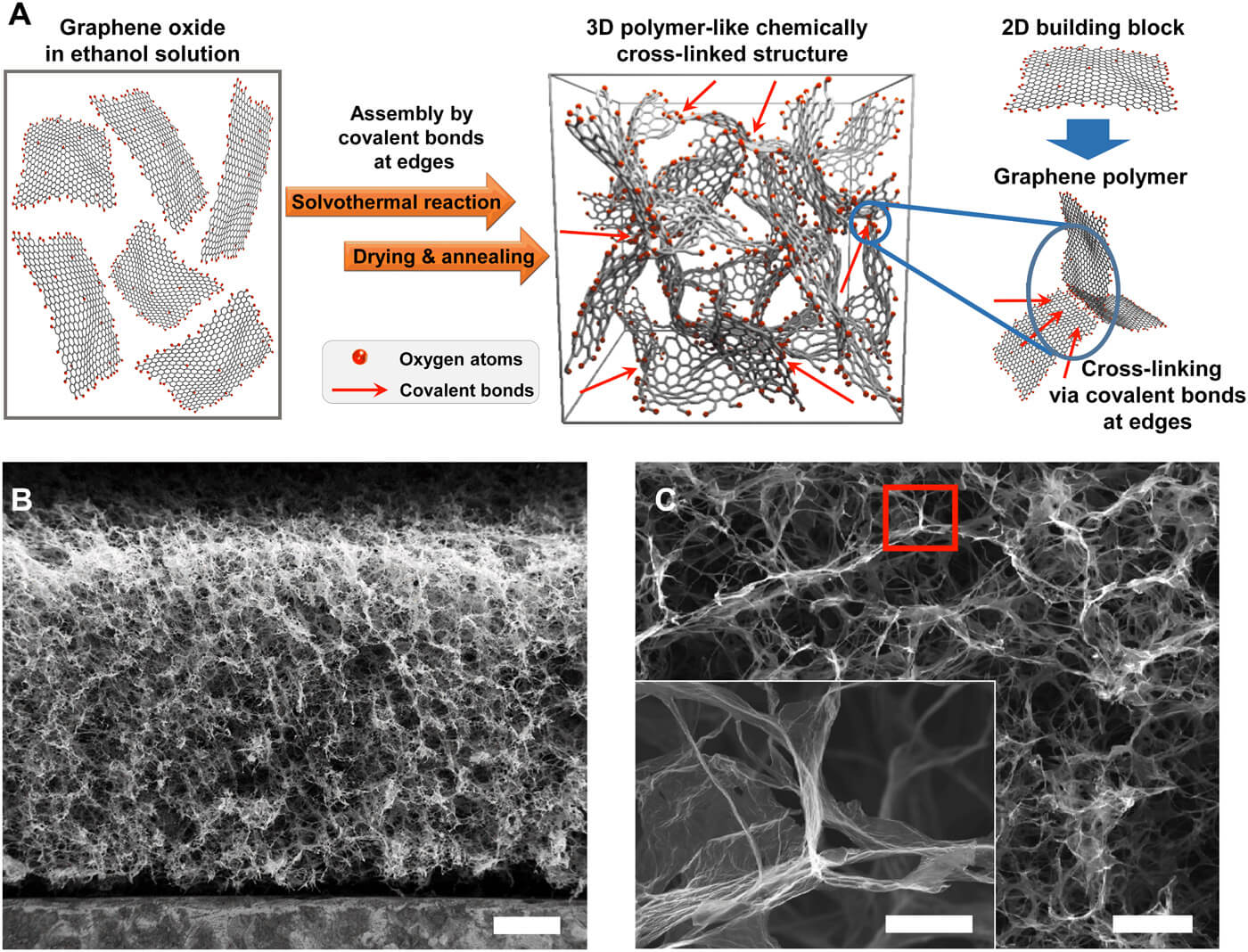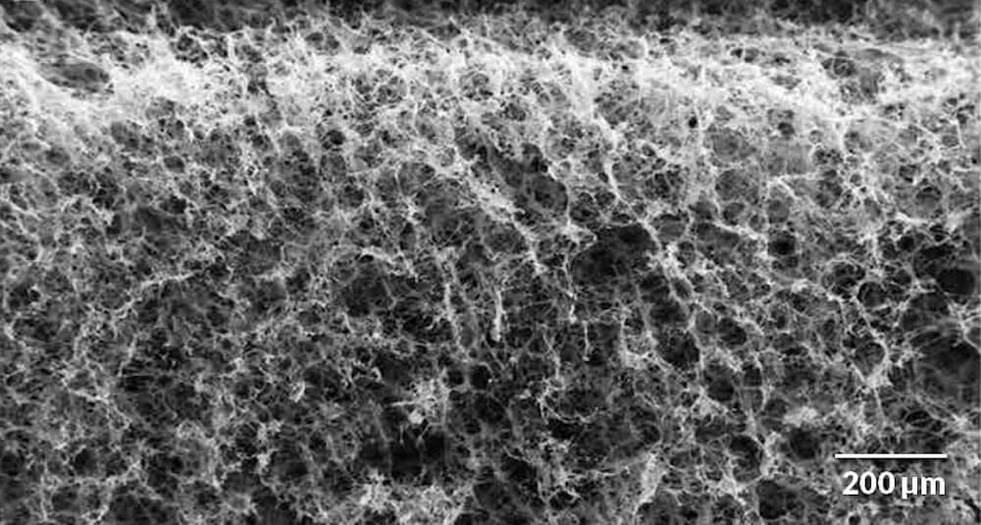Normal materials become brittle in deep cryogenic conditions, but a new graphene-based foam (shown in this scanning electron microscopy image) stays as flexible as ever. Image credit: Kai Zhao et al., Science Advances
Typical elastic materials made from flexible polymers lose their elasticity at about 55 degrees Celsius. Of course, materials do exist that can handle frigid temperatures without breaking, but elasticity and ductility are generally compromised at these low temperatures.
Many applications like from aerospace to medical to oil and gas require materials that remain elastic, almost intact, at much lower temperatures and the material property has limited this requirement.
But now one group of materials that have been suggested for these applications by a team of researchers from Rice University, Houston, and at Nankai University, China is carbon nanomaterials.
A material that remains flexible at such low temperatures could be used to build devices for use in space, researchers report online April 12, 2019, in the journal Science Advances.
From the published paper, ‘Until now, materials with high elasticity at deep cryogenic temperatures have not been observed. Previous reports indicated that graphene and carbon nanotube-based porous materials can exhibit reversible mechano-elastic behavior from liquid nitrogen temperature up to nearly a thousand degrees Celsius. Here, we report wide temperature–invariant large-strain super-elastic behavior in three-dimensionally cross-linked graphene materials that persist even to a liquid helium temperature of 4 K, a property not previously observed for any other material. To understand the mechanical properties of these graphene materials, we show by in situ experiments and modeling results that these remarkable properties are the synergetic results of the unique architecture and intrinsic elastic/flexibility properties of individual graphene sheets and the covalent junctions between the sheets that persist even at harsh temperatures. These results suggest possible applications for such materials at extremely low-temperature environments such as those in outer space.’
Researchers explained in a recent paper, "Carbon nanomaterials, such as carbon nanotube (CNT) and graphene, have been thought as suitable building blocks for making temperature-invariant elastic materials because of their extraordinary mechanical properties, flexibility, and exceptional thermal stability. However, it has been a great challenge to realize these intrinsic properties in the bulk material scale, because restacking and/or agglomeration of nano-individuals (graphene sheets or nanotubes) severely diminish or weaken most of their intrinsic properties."
Though Carbon nanomaterials, such as carbon nanotube (CNT) and graphene, have been thought of as suitable building blocks for making temperature-invariant elastic materials because of their extraordinary mechanical properties, flexibility, and exceptional thermal stability, they also encompassed challenges. Because restacking and/or agglomeration of nano-individuals (graphene sheets or nanotubes) severely diminish or weaken most of their intrinsic properties, researchers faced problems in realizing the intrinsic properties in the bulk material scale.
A compressive elastic three-dimensional (3D) graphene materials that show large and reversible deformation at room temperature, in liquid nitrogen (77 K), and an inert atmosphere up to 900°C has been already conducted but the experiments at extremely low temperatures are very challenging and also because no such material with super-elasticity at deep cryogenic temperatures has been reported or predicted before. So, the researchers, led by professors Yongsheng Chen of Nankai University and Pulickel M. Ajayan of Rice University, thought of studying cryogenic mechanical properties for bulk graphene materials at liquid helium temperature which have not been studied yet. The team wondered whether the super-compressive elasticity and other mechanical properties of graphene foams would be maintained at extreme temperatures, such as at liquid helium temperature, and whether the remarkable mechanical properties of graphene materials could be maintained both at deep cryogenic temperatures and at bulk scales.
Using a 3D cross-linked graphene foam they had previously developed, the researchers investigated the mechanical properties of graphene foam in liquid helium using a homemade in situ large-strain mechanical analysis system. Their system could continuously monitor material deformations from "deep cryogenic temperature at 4 K [-270°C] to a high temperature of 1,273 K [1,000°C]" without breaking the vacuum seal.

The team systematically and quantitatively investigated the mechanical properties of the 3D Graphene foam using a homemade in situ large-strain mechanical analysis system and the results are impressive. They observed that even at liquid helium temperature, the 3D Graphene foam, in which randomly oriented graphene sheets are chemically cross-linked through covalent bonds mainly at the edges, exhibits the same mechanical properties like those at room temperature. They also showed nearly fully reversible super-elastic behavior of up to 90% strain, unchanged Young’s modulus, near-zero Poisson’s ratio, and great cycle stability. Furthermore, these mechanical properties are also quantitatively proved to be temperature invariant over a wide temperature range from deep cryogenic temperature (liquid helium, 4 K) to 1273 K.
The team conducted their researcher in several stages, mainly including:
-
Apparatus for in situ and variable-temperature mechanical measurements: They first designed an apparatus for variable-temperature mechanical measurements from 4 to 1273 K. A homemade mechanical analysis apparatus that can withstand liquid helium temperatures was used to overcome the temperature limitation of commercial systems. To exclude the influence introduced by the interaction between the pore/cell walls (graphene sheets) and the fluid on the mechanical properties, the team performed all the tests here for the 3D Graphene material from cryogenic to high temperature in high vacuum (10-4 Pa). On first investigating the mechanical properties of the 3D Graphene foam by a single uniaxial compress-release operation at 4 K using the abovementioned homemade mechanical analysis apparatus, they observed the super-compressive elasticity of the material, which combines both large strains up to 90% and high reversibility.
-
Synthesis of 3D Graphene
-
Preparation of 3D Graphene samples
-
Methods for statistical analysis and error bars
Combining the results from the measurement of strain, Young’s moduli and Poisson’s ratios of the 3D Graphene at different low and high temperatures, Young’s modulus and near-zero Poisson’s ratio of the material demonstrated remarkable temperature independence in a wide temperature range from liquid helium temperature to 1273 K. Also, they found the isotropic characteristic for the mechanical properties of the 3D Graphene foam is also temperature independent from 4K to 1273 K. Furthermore, after high-temperature mechanical tests, all the mechanical properties (stress-strain behavior, Young’s modulus, Poisson’s ratio, and cycle stability) at room temperature and low temperature remained unchanged for the same sample.
They stated that these unique mechanical behaviors arise from the remarkable temperature-invariant elasticity and flexibility of the individual graphene sheets and covalent junctions between the sheets in the bulk material. The temperature-invariant elasticity and flexibility of graphene is the result of the unique bonding of carbon in the sp2-hybridized planar graphene sheets with soft out-of-plane bending modes and strong in-plane stretching modes with very high energy for defect formation. The intrinsic temperature-invariant mechanical properties of graphene, combined with the unique cross-linked structure and high porosity of the 3D Graphene material, make the bulk material fully elastic and other temperature-invariant mechanical properties down to liquid helium temperature.
In the future, the researchers say that if similar bulk materials could be made from other 2D materials using the same assembly strategy, then "some unexpected and fascinating properties, not only the mechanical aspect, might be discovered."
